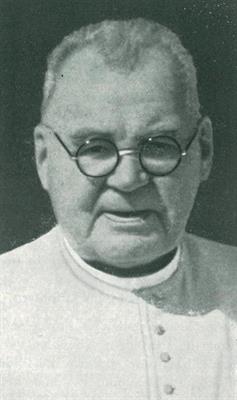Dominikus (Josef Ferdinand) Dietrich OPraem

Personalia
Order Name:
Born:
Died:
Profession:
Persecution:
Police custody 1939 and 1940,
Banned from the town in 1940,
security money 1944
Memberships
Curriculum Vitae
Josef Ferdinand Dietrich entered the Premonstratensian monastery in Wilten after graduating from high school in 1889. Here he was given the monastic name Dominikus. After the novitiate, he studied theology at the monastery's own school from 1890 and was ordained a priest in 1894. He then worked at the monastery from 1894-1930 as a lecturer in philosophy and dogmatics, as well as being novice master from 1910-1914 and prior from 1914-1934. From 1930 until his death, he took on pastoral duties as parish priest of Wilten.
During the First World War, he served as Vice President of the Red Cross. He also supported the construction of emergency churches in Pradl-Süd (Konradskapelle) and Wilten-West as well as the Theresienkirche on the Hungerburg.
In 1920, he was accepted as an honorary member of Vindelicia, where he was awarded a doctorate in 1931 for his services to the construction of the Vindelikerhaus - as chairman of the building committee since 1926. In 1921, he was also accepted as an honorary member of Leopoldina, where he also played a key role in the purchase and adaptation of the Leopold House.
In 1923, he was a member of the National Council for a few weeks and a member of the Central Committee for Germans Abroad. After the invasion of Austria by the Wehrmacht, Dominiks Dietrich was very quickly targeted by the new rulers and reprimanded, for example because of a church wall newspaper from Neuburg Monastery on the third Sunday of Lent, where Franz Hofer, Gauleiter of Tyrol-Vorarlberg, understood the Gospel quotation there as an allusion to the NSDAP, which would be overcome and thrown out by a stronger party.
On August 26, 1939, Wilten Abbey was dissolved and Dominikus Dietrich moved to the old provincial court building. In a letter addressed to Adolf Hitler's private office, which could be smuggled to Munich due to the strict controls on letters and sent from there to Berlin, he asked for the monastery's confiscation to be lifted, citing the monastery's eight hundred years of service to German culture in Tyrol. The letter was sent back to Gauleiter Hofer, who immediately had Dominkus Dietrich arrested for allegedly lying to the Führer, as the monastery had not been abolished but had become the property of the Gau through a valid purchase agreement.
After eight days in the Hotel Sonne, he was arrested again. Two weeks later, on the occasion of the Feast of the Rosary, he carried out the usual and prescribed procession in the cloister of the monastery, whereupon he was arrested again the next day and the collegiate church was locked up - it later served as a furniture warehouse. After eight days, he was released with a warning. In the summer of 1940, he was briefly imprisoned again because of a youth appeal. His advanced age persuaded the Gestapo not to send him to Dachau concentration camp, but instead to expel him from the country. Through the mediation of the then provicar Carl Lampert, the banishment was set at six months. Dominikus Dietrich went to Schlägt Abbey in Upper Austria and returned to Innsbruck at the end of the period.
Places
Place of activity:
Citations
Krause, Peter/Reinelt, Herbert/Schmitt, Helmut (2020): Farbe tragen, Farbe bekennen. Katholische Korporierte in Widerstand und Verfolgung. Teil 2. Kuhl, Manfred (ÖVfStG, Wien) S. 49/50.
